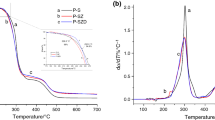Abstract
The aim of this study was to gain some fundamental knowledge on the thermal degradation pathways of poly(N-vinyl pyrrolidone) using Thermogravimetry coupled with Fourier Transform Infrared Spectroscopy (TG–FTIR) in addition to IR and 1H NMR spectroscopic studies of the partially degraded samples. It was found that the vinyl pyrrolidone is the main volatile products of the thermal degradation of PVP which implies that the predominant mechanism during thermal degradation of this polymer is the depolymerization to monomer of the polymeric main chain; however, it is evident that simultaneous reactions may be involved yielding oligomers. FTIR and 1H NMR spectra of partially degraded samples of PVP exhibited very similar characteristics to that observed for undegraded samples although the 1H NMR spectra suggest the presence of simultaneous reactions as the fragmentation of polymeric main chain.






Similar content being viewed by others
References
Kumar SV, Musturappa TE, Prasannakumar S, Mahadevan KM, Sherigara BS. N-Vinylpyrrolidone and ethoxyethyl methacrylate copolymer: synthesis, characterization and reactivity ratios. J Marcomol Sci A. 2007;44:1161–9.
Wang W, Zhang Y, Zhu M, Chen Y. Effect of graft modification with poly(n-vinyl pyrrolidone) on thermal and mechanical properties of poly(3-hydroxybutyrate-co-3-hydroxyvalerate). J Appl Polym Sci. 2008;109:1699–707.
Bianco G, Soldi MS, Pinheiro EA, Pires ATN, Gehlen MH, Soldi V. Thermal stability of poly(N-vinyl-2-pyrrolidone-co-methacrylic acid) copolymers in inert atmosphere. Polym Degrad Stab. 2003;80:567–74.
Bogatyrev MV, Borisenko NV, Pokrovskii VA. Thermal degradation of polyvinyl pyrrolidone on the surface of pyrogenic silica. Russ J Appl Chem. 2001;74:839–44.
Peniche C, Zaldívar D, Pazos M, Paz S, Bulay A, San Román J. Study of the thermal degradation of poly(N-vinyl-2-pyrrolidone) by thermogravimetry-FTIR. J Appl Polym Sci. 1993;50:485–93.
Lau C, Mi Y. A study of blending and complexation of poly(acrylic acid)/poly(vinyl pyrrolidone). Polymer. 2002;43:823–9.
Silva MF, da Silva CA, Fogo FC, Pineda EAG, Hechenleitner AAW. Thermal and FTIR study of polyvinylpyrrolidone/lignin blends. J Therm Anal Calorim. 2005;79:367–70.
Aggour YA. Characterization and evaluation of copolymers of end-allenoxy polyoxyethylene macromonomers and N-vinyl-2-pyrrolidone. Eur Polym J. 1999;35:1173–8.
Rao V, Latha P, Ashokan PV, Shridhar MH. Thermal degradation of poly(N-vinylpyrrolidone)-poly(vinyl alcohol) blends. Polym J. 1999;31:887–9.
Kim SJ, Park SJ, Kim IY, Lee YH, Kim SI. Thermal characteristics of poly(vinyl alcohol) and poly(vinylpyrrolidone) IPNs. J Appl Polym Sci. 2002;86:1844–7.
Mendes LC, Rodriguez RC, Silva EP. Thermal, structural and morphological assessment of PVP/HA composites. J Therm Anal Calorim; 2010. doi: 10.1007/s10973-010-0835-4.
Cervantes-Uc JM, Cauich-Rodríguez JV, Vázquez-Torres H, Garfias-Mesías L, Paul DR. Thermal degradation of commercially available organoclays studied by TGA–FTIR. Thermochim Acta. 2007;457:92–102.
Dutta K, Brar AS. Poly(vinylpyrrolidone): configurational assignments by one- and two-dimensional NMR spectroscopy. J Polym Sci A. 1999;37:3922–8.
Hoppe CE, Lazzari M, Pardiñas-Blanco I, López-Quinela MA. One-step synthesis of gold and silver hydrosols using poly(N-vinyl-2-pyrrolidone) as a reducing agent. Langmuir. 2006;22:7027–34.
Bartolozzi I, Solaro R, Schacht E, Chiellini E. Hydroxyl end-capped macromers of N-vinyl-2-pyrrolidinone as precursors of amphiphilic block copolymers. Eur Polym J. 2007;43:4628–38.
Raith K, Kühn AV, Rosche F, Wolf R, Neubert RHH. Characterization of povidone products by means of 13C-NMR, MALDI-TOF, and electrospray mass spectrometry. Pharm Res. 2002;19:556–60.
Author information
Authors and Affiliations
Corresponding author
Rights and permissions
About this article
Cite this article
Loría-Bastarrachea, M.I., Herrera-Kao, W., Cauich-Rodríguez, J.V. et al. A TG/FTIR study on the thermal degradation of poly(vinyl pyrrolidone). J Therm Anal Calorim 104, 737–742 (2011). https://doi.org/10.1007/s10973-010-1061-9
Received:
Accepted:
Published:
Issue Date:
DOI: https://doi.org/10.1007/s10973-010-1061-9




